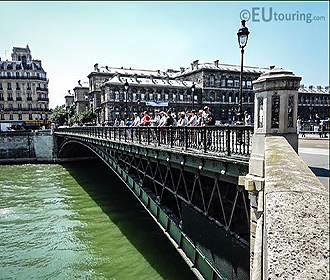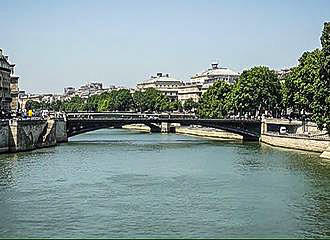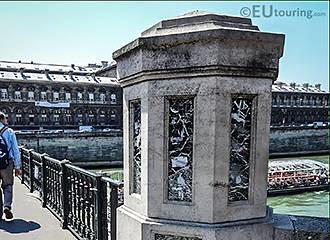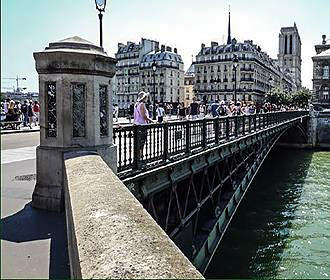Paris Pont d'Arcole bridge in France
The Paris Pont d'Arcole bridge in France was constructed in the 1800s from the Ile de la Cite over the River Seine to the right bank and the Hotel de Ville, or City Hall, and with an innovative design, it was the first bridge without a support in the river.
Pont d'Arcole bridge history
It was back in the 18th century that the city thought there should be a bridge connecting the Ile de la Cite by the Notre Dame Cathedral over to the Hotel de Ville in Paris, however, it took until 1828 for a pedestrian bridge to be constructed.
This first bridge was sometimes referred to as the Pont de l'Hotel de Ville or the Passerelle de Greve and was a two span suspended bridge with one central support pier in the river.
However, in 1854, it was decided that this bridge over the River Seine should be replaced with a traffic bridge that would be able to handle the growth and development of the city, especially with the developments that were going on in the area, like the extension of the Rue de Rivoli by the Musee du Louvre.
There were actually two entirely different design concepts submitted for the new Paris bridge, one with three stone arches, and the other by retired engineer Alphonse Oudrey in conjunction with Nicolas Cadiat and it was this second proposal that was decided upon by the city council.
Eventually it was constructed in 1856 and named the Paris Pont d'Arcole bridge in France, but in 1888, it sagged by approximately 20cm and had to be strengthened by adding two additional trusses and making the deck lighter, yet the only other major change was to hollow out the right bank abutment to let the roadway through when the Goerges-Pompidou expressway was constructed.
About the Paris Pont d'Arcole bridge in France
Now the Paris Pont d'Arcole bridge in France was a very innovative design for its time when constructed with not a single supporting pier in the River Seine, and with only one low sweeping arch, it was the first bridge in Paris of its kind.
Having a metal construction with a reinforced concrete deck and a span of 80m, there are only four keystones that make up any decoration on the Paris Pont d'Arcole bridge in France, so it is far less elaborate than some other Paris bridges.
And it is commonly thought that the name chosen of Pont d'Arcole was to commemorate the victory by Napoleon Bonaparte I at the Battle of the Bridge of Arcole, although there is still some disagreement as to whether this is true.
Also the Paris Pont d'Arcole bridge in France was used for the armoured division of General Leclerc to travel over to reach the Hotel de Ville, when there was the victory parade and speech made by General Charles de Gaulle at the Liberation of Paris in the August of 1944.
Visiting the Paris Pont d'Arcole bridge in France
You will find the Paris Pont d'Arcole bridge in France spanning the River Seine from the Ile de la Cite island in between the Quai de la Corse and the Quai aux Fleurs by the road that goes to the Parvis Notre Dame and the Notre Dame Cathedral.
It then travels over to the right bank in between the Quai de Gesvres and the Quai de l’Hotel de Ville, which is where you will find the Paris square formerly known as the Place de Greve and now the Place de l’Hotel de Ville, which is in front of the City Hall in Paris.
And when standing on the Paris Pont d'Arcole bridge in France, if you look upstream you can see the Pont Louis Philippe bridge, and downstream is the Pont Notre-Dame bridge, and as you can no doubt tell, there are numerous Paris tourist attractions and Paris monuments in this area, including the Tour Saint Jacques Tower and the Place de Chatelet to name a couple.
As for Paris public transport, the nearest Metro stations to the Paris Pont d'Arcole bridge in France are either the Hotel de Ville stop via lines 1 and 11, or the Cite stop on the Ile de la Cite via line 4. Yet the Batobus water bus also has a dock on the right bank close by, and the tour buses such as Paris Tootbus tours also stop near to this historical bridge.



